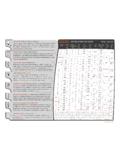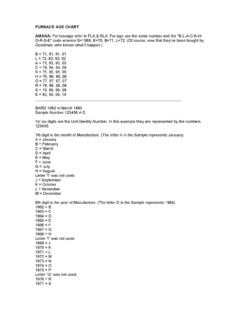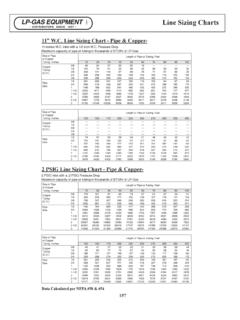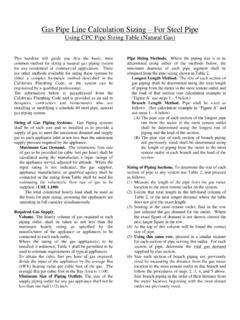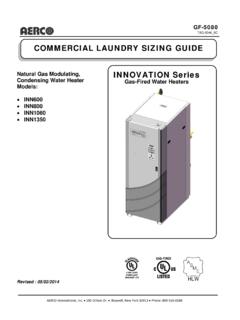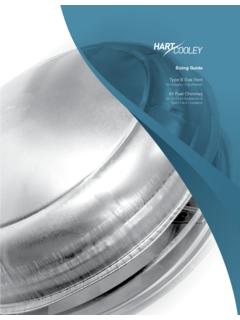Transcription of VENTING VENTING Gas AppliancesGas Appliances
1 Most furnaces, boilers, andwater heaters going intohomes today are notsuper-efficient sealedcombustion or direct vent are mid-efficiency atmospheric-vented Appliances that use a regularvent or chimney, relying on naturalbuoyancy to carry the hot gases up theflue and out at the compared to yesterday s 65%efficient units, modern 78% to 83%efficient, naturally vented applianceskeep more heat in the house and sendless heat up the flue and that makesthings tricky. The cooler the flue gas,the weaker the draft and the greaterthe risk of exhaust also increases the riskof condensation and corrosion in thevent. Gas burner exhaust is mostly car-bon dioxide and water vapor, and inmodern systems, that moist mix entersthe flue at a temperature not far aboveits dew point of 140 F. If the moisturehits a cool surface, or just takes toolong to reach the top of the system, it slikely to condense and because thevapor contains trace amounts ofoxides of nitrogen, the condensate is aweak nitric acid solution that can cor-rode masonry or metal (see Figure 1,next page).
2 If vents and chimneys get wet onlyoccasionally and dry out quickly, dam-age isn t likely. But systems that getwet and stay wet can corrode badly,and fast. To minimize wet time, modern vent systems have to be sizedjust right large enough to handlethe exhaust but small enough to warmup quickly, so that any condensationwill dry up before the equipment shutsdown and the flue won t stay wetbetween choices affect vent func-tion, too. Masonry chimneys that takea lot of heat to warm up and uninsu-lated single-wall vent pipe that allowsexcessive heat loss have limited useful-ness with modern gas equipment. Forthe most part, those old materials arebeing replaced by insulated double-wall B vent, which warms up quicklyand has an aluminum inner lining toresist with modern vent materials,FEBRUARYJLC2003 For a safe gas flue, use the right materials, size by the book, and always perform a combustion test by Bob Dwyer & Mark GronleyVENTING VENTING Gas AppliancesGas Appliancesthe rules for designing and sizing ventsystems are complicated.
3 With modernsystems, the old common sense rulesof thumb can be a recipe for failure. Infact, following the latest rule book reli-giously isn t always enough. To makesure the system works the way theinstaller intended, a trained technicianshould use combustion and draft test-ing instruments to check each installa-tion against the manufacturer s Rules, New ProblemsIn the early 1990s, after the govern-ment raised efficiency requirements to78% for gas boilers and 80% for gasfurnaces, there was a rash of com-plaints about back-drafting and corro-sion in flues. In response, the gasindustry made another rule change: Itreplaced the old, simple ratios of ventand chimney sizing with an elaboratenew set of vent- sizing lookup tables,based on extensive research by BatelleLaboratories and the Gas ResearchInstitute (GRI). The goal was to makesure that flues not only would drawproperly, but also would stay as dryinside as new sizing tables are publishedin the National Fire ProtectionAssociation (NFPA) National Fuel GasCode( ), in model build-ing codes, and in manufacturer hand-books and instructions.
4 They re alsothe basis for computer software pack-ages such as Elite Software s Gasvent( ), which automatesthe tedious process of cross-checkingvent and appliance tables specify the height, lateralrun, and diameter of vents and ventconnectors for a whole range of situa-tions, depending on the vent materialand on the size and type of the appli-ance or combination of appliancesbeing vented. And you can work thesystem in reverse: If you know the ventmaterial, the vent diameter, and thehorizontal and vertical layout of thevent system, the tables tell you whatsize appliance the vent can , many installers stilldon t understand why the new rulesexist or how they work, and they alsomay not understand that changingventing materials can change therequirements. When we test and inspectinstallations in the field, we continue tosee enough mistakes to know that a lotof technicians are still doing things the way we ve always done it withpredictably bad ingas flues is acidic and canattack vents and white deposits andrust are signs of corrosion(top left), which can perfo-rate vent pipe and allowfumes to leak (top right).
5 Chimneys are especiallyvulnerable: Acidic conden-sate eats through tile flueliners (bottom left) anddestroys brick masonry(bottom right). It takes50,000 Btus to heat amasonry chimney abovethe dew point of gas appli-ance exhaust, while only125 Btus are needed towarm a B vent BallancoDennis RobitailleJohn MorrisonJohn MorrisonGas furnaces, boilers, and waterheaters are safe and reliable wheneverything is done right. But buildersand remodelers should be extra carefulto use hvac technicians who thor-oughly understand and follow therules, and who check every installationwith professional Range of Options There s a wide range of choice inappliances and vents. But for everycombination of equipment type andvent material, the basic goals and lim-its apply: The vent must be able to pro-vide sufficient draft for the equipment;it must be warm and dry enough toavoid damaging corrosion; and it mustbe fire safe.
6 The sizing tables and otherventing rules aim to achieve that safetyand durability, but in providing for thewhole range of choices, the rules havebecome mid-efficiencyfurnaces and boilers are fan-assisted units, which use an inducer fan to pushor pull air through the combustionchamber (Figure 2, previous page). Thefans help overcome resistance to airflowwithin the appliance and create turbu-lence for better combustion and heatexchange, to boost efficiency. But theydon t pressurize the vent system: Oncethe exhaust leaves the unit, it still needsthe negative pressure of buoyancy inthe vent to draw it out of the heaters have slightly less strin-gent efficiency standards, so most ofthem still use the old draft-hood tech-nology and rely on natural convectionto pull air into the combustion draft hoods let dilution air enter theflue, which provides some drying (but atthe cost of lower total efficiency).
7 One cubic foot of natural gas sup-plies about 1,000 Btus of energy. Fan-assisted units need about 15 ofair to fully combust that 1 offuel, producing about 16 of cool,damp exhaust. Draft-hood unitsrequire an additional 14 or 15 ofdilution air for each 1 of fuelconsumed, producing roughly 30 relatively drier exhaust products forthe flue to handle. (The ratios areslightly different for propane, but theprinciple is the same.)This difference between fan-assist anddraft-hood performance has an effecton VENTING requirements. Because adraft-hood appliance creates a large vol-ume of exhaust, it needs a taller orlarger-diameter vent than a fan-assistedFEBRUARYJLC2003 DrainTemperature &pressure relief valveGas controlsBurnerExhaust bafflesThermocoupleDip tubeSacrificial anodeVentFigure Category I furnaces (above) usean inducer fan to overcome air resistance in the com-bustion chamber but do not pressurize the vent dilution air is introduced, so the exhaust is dampand condenses readily.
8 Draft-hood water heaters (right)rely on natural draft to bring in combustion air, and thedraft hood allows dilution air to mix with flue gases,wasting some energy but creating a drier flue gas. Thetwo types have different vent size requirements but canbe common-vented on a single flue as long as sizingrules are of the same Btu rating. Oversizing,however, isn t a problem: A vent servinga draft-hood unit can only be too small,not too vent that serves a fan-assisted appli-ance, on the other hand, can be toosmall ortoo large. Because its exhaustgas is relatively cool and damp, the fan-assisted unit won t warm the ventquickly enough to prevent damagingcondensation (and with fan-assistedequipment, there s no drying airflowthrough the system when the unit s notrunning). So for each vent configura-tion listed (height, lateral run, anddiameter), the tables show both a mini-mum and maximum allowable Btu rat-ing for fan-assisted equipment ( fanmin.)
9 And fan max. ). For draft-hoodequipment, the tables show only thelargest equipment permitted on thevent ( nat max. ) there is no mini-mum. For two Appliances common-vented on the same flue, the tablesprovide a complex range of optionsdepending on whether the setupinvolves two fan Appliances , two nat Appliances , or one of sizing tablesalso must account for the differentbehavior of different vent chimneys take a long time toheat up and are prone to condensa-FEBRUARYJLC2003 Figure height, vent lateral run, ventdiameter, and vent material all must befactored into the sizing match between anappliance and its vent system. In general,tall B vents with no lateral runs offer thegreatest freedom of choice for appliancesize. Lateral runs, elbows, and single-wallvent pipe sharply degrade vent perfor-mance and restrict appliance selection.
10 Inthe example of a 10-foot vent height witha 5-foot lateral run (circled in table), a 4-inch B vent and B vent connector canserve any fan-assisted appliance largerthan 32,000 Btu/hr and smaller than113,000 Btu/hr. Increasing the vent diam-eter to 6 inches raises the minimum to52,000 Btu/hr and the maximum to280,000 Btu/hr. But using a single-wallvent connector shrinks the maximum to111,000 Btu/hr while raising the minimumto 76,000 Btu/hr. Fan-assisted appliancesare ruled out for masonry chimneysregardless of connector heightVent lateralfan '0'017510004472552'1711881262891955'3211 3775228018810'4110470 6726717515'0'019111205022852'15136932233 92255'30130874933021710'4012182643152081 5'4811276763011986-inch-diameter vent4-inch-diameter ventSingle Appliance, Continuous B VentVent heightVent lateralfan '0'57174991204442542'59117801192871945'7 61117614827718610'971006818826117115'0'5 61901111164992832'57136931153372245'7512 88614432621710'951167918230820315'NANA72 2202901924-inch-diameter vent6-inch-diameter ventSingle Appliance, Single-Wall Connector to B VentLength oflateral (L)Totalventheight(H)tion, so they can serve only a veryrestricted range of appliance sizes (andseldom if ever can handle a fan-assisted unit by itself).
